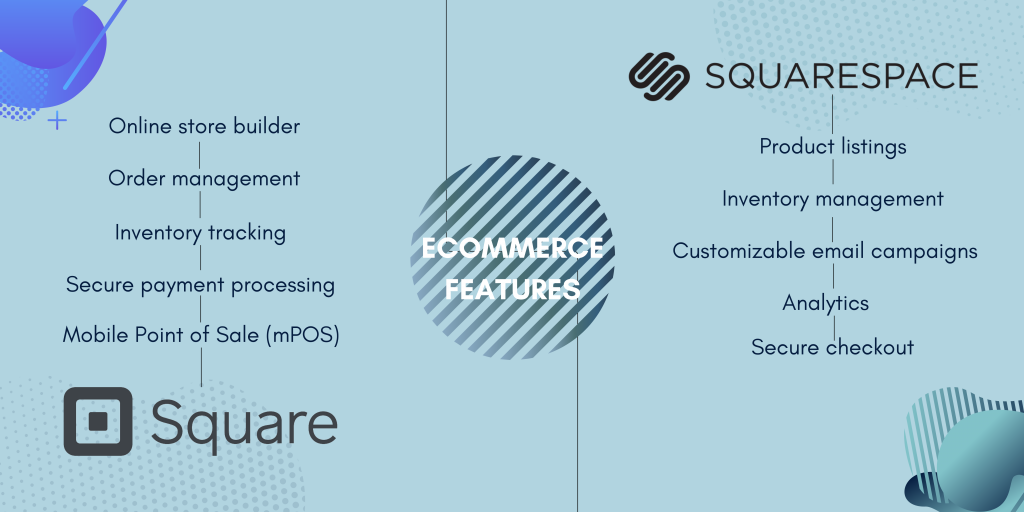Selecting the right ecommerce platform for your business is crucial when you’re building your online presence. Your choice can significantly impact your store’s success: from ease of use to payment processing and customization options.
In this article, we will delve into the nuances of two prominent platforms: Square vs Squarespace. As an ecommerce business owner or financial specialist, understanding the differences between these two platforms is vital for making an informed decision that aligns with your unique business goals.
Understanding the Square vs Squarespace Difference
Before we explore the specific features and capabilities of Square and Squarespace in the context of ecommerce, let’s establish a clear understanding of what Square and Squarespace represent in the ecommerce landscape.
An overview of Square
Square, founded in 2009 by Jack Dorsey and Jim McKelvey, revolutionized payment processing with its mobile credit card reader. Over the years, Square evolved into a multifaceted financial services company, offering an array of business tools and solutions.
In the ecommerce sphere, Square is prominently represented by Square Online. This platform serves as a user-friendly website builder and ecommerce solution tailored to small and medium-sized businesses. Its intuitive interface makes it accessible to both seasoned ecommerce professionals and newcomers, while robust inventory management, seamless payment processing, and mobile responsiveness cater to the unique needs of online businesses. Square Online’s adaptability is evident in its successful implementation by a wide range of businesses, from small retailers to restaurants, facilitating their entry into the digital marketplace.
Square’s journey showcases its dedication to simplifying financial processes for businesses. From its groundbreaking mobile card reader to its current comprehensive suite of services, including Square Online, the company empowers entrepreneurs with accessible and innovative solutions. For small and medium-sized businesses seeking a dependable ecommerce platform with a seamless blend of features and ease of use, Square Online, backed by Square’s track record of simplicity and innovation, stands as a valuable choice in the ever-evolving digital business landscape.
When using Square as your payment processor, you might want to integrate it with accounting. Synder helps smooth integration of Square with accounting solutions, such as QuickBooks, Xero, etc., for always accurate recordkeeping, smooth reconciliation and facilitated tax preparation.
Book a seat at Synder free demo to learn more and have your questions answered or sign up for a free trial to see whether Synder is the right fit for your business.
An overview of Squarespace
Squarespace, founded in 2003 by Anthony Casalena, has gained renown as a web development and hosting platform. Initially focused on website creation, Squarespace has made a name for itself through its visually appealing website templates and user-friendly website builder. These templates, designed with an emphasis on aesthetics and user experience, have become synonymous with Squarespace’s reputation for creating professional and engaging websites.
Squarespace’s user-friendly website builder sets it apart in the web development sphere. Its intuitive interface ensures accessibility for individuals and business owners with varying levels of technical expertise. This approach allows users to design and manage their websites without the need for extensive coding or design skills, making it an ideal choice for those looking to establish a strong online presence quickly and efficiently.
Recognizing the evolving needs of businesses, Squarespace has expanded its offerings to encompass robust ecommerce capabilities. Today, it stands as a versatile platform for businesses aiming to enter the world of online retail. Squarespace’s ecommerce features cover product listings, inventory management, secure payment processing, customizable email campaigns, and detailed analytics. This diversification enables businesses across different industries to leverage the platform’s resources and tools to create and manage successful online stores.
Square Online: A deep dive
Now that we have a basic understanding of Square and Squarespace, let’s take a closer look at Square Online and its ecommerce capabilities.
Square Online is an all-in-one ecommerce platform that aims to simplify online selling for businesses of all sizes. Here are some key features and aspects of Square Online:
- User-friendly interface
Square Online is renowned for its user-friendly interface, making it accessible for business owners with varying levels of technical expertise. Whether you’re a seasoned ecommerce professional or a newcomer, you’ll find it easy to navigate and use. - Inventory management
One of Square Online’s strengths lies in its inventory management tools. You can easily add, edit, and organize products, making it simple to keep your online store up to date. The platform allows you to set up item variations, manage stock levels, and even categorize products for a seamless shopping experience. - Payment processing
Square Online seamlessly integrates with Square’s payment processing services. This integration ensures secure and efficient payment transactions for your customers. Square offers various payment options, including credit card processing, digital wallets, and even contactless payments. - Mobile responsiveness
In the era of mobile shopping, Square Online doesn’t disappoint. Your online store built with Square Online is inherently mobile-responsive, ensuring that it looks and functions well on smartphones and tablets. This is crucial for reaching the growing number of mobile shoppers. - Real-world use cases
Square Online has gained popularity among small businesses, restaurants, and retailers. Its adaptability and ease of use make it a preferred choice for those looking to establish an online presence or streamline their existing ecommerce operations.
Squarespace: unpacking the ecommerce potential
Squarespace, originally known for its website builder, has evolved to offer a robust suite of ecommerce features that cater to businesses of various sizes and industries:
- Visually appealing templates
Squarespace is renowned for its stunning website templates. These templates provide a visually appealing backdrop for your online store, creating a professional and attractive online presence that can help you stand out in the competitive ecommerce landscape. Whether you’re selling fashion, art, or electronics, Squarespace offers templates that align with your brand’s aesthetics. - Customization options
Squarespace provides extensive customization options, making it an ideal choice for businesses that want to create a unique and branded online store. You can easily tweak the design elements like fonts, colors, and layout to match your brand’s identity. This level of customization empowers you to create a one-of-a-kind ecommerce website that resonates with your target audience. - Payment processing
Squarespace offers flexibility when it comes to payment processing. It supports various payment gateways, including Stripe, PayPal, and Square. This flexibility allows your customers to choose their preferred payment method, enhancing the overall shopping experience. Additionally, Squarespace provides secure checkout processes to instill confidence in your customers. - Inventory management
Effective inventory management is crucial for ecommerce success. Squarespace offers tools for managing your product catalog. You can categorize products, set stock levels, and create product variations. This simplifies the process of keeping your online store organized and up to date. - Examples of success
Many successful online businesses have thrived using Squarespace’s platform. Whether you’re in the creative arts, fashion, or any other industry, Squarespace provides a solid foundation for launching and scaling your ecommerce venture.
Square and Squarespace features for ecommerce businesses
Ecommerce businesses come with unique requirements that extend beyond the capabilities of standard websites. Both Square and Squarespace recognize these distinct needs and have tailored their platforms to cater to them.
Here’s an in-depth look at how each platform addresses the specific requirements of ecommerce

Square Online’s features
Square Online offers a comprehensive suite of ecommerce features designed to help businesses thrive in the online marketplace. These features include:
- Online store builder
Square Online’s online store builder stands out for its user-friendly nature. It simplifies the process of creating and launching an online store. Business owners can choose from professionally designed templates and effortlessly customize them to align with their brand identity. This intuitive approach ensures that even those with minimal web design experience can create an appealing and functional online store. - Order management
Efficient order management tools are essential for ecommerce success, and Square Online delivers in this regard. It empowers businesses to process orders seamlessly, track order statuses in real-time, and communicate with customers efficiently. This streamlined approach ensures that customers receive prompt updates on their orders, leading to enhanced satisfaction and loyalty. - Inventory tracking
Accurate inventory management is crucial for preventing overselling and ensuring product availability. Square Online’s inventory management system simplifies this task by enabling businesses to monitor product availability in real-time. It even allows for the setup of automatic stock alerts to prevent the inconvenience of overselling. This proactive approach helps businesses maintain a positive customer experience. - Secure payment processing
Security is paramount in ecommerce, especially concerning payment transactions. Square Online excels in this area by integrating seamlessly with Square’s payment processing services. This integration ensures that payment transactions are not only secure but also reliable. Customers can complete their purchases with confidence, knowing that their financial information is protected. - Mobile Point of Sale (mPOS)
Square Online offers integration with Square’s mobile point of sale (mPOS) system. This functionality provides businesses with the flexibility to manage both online and in-person sales. This cohesive approach to multichannel sales allows businesses to serve their customers seamlessly, whether they’re shopping online or visiting a physical store location.
Squarespace ecommerce features
Squarespace provides an array of features specifically designed to empower ecommerce businesses. These features include:
- Product listings
Creating and managing product listings is a fundamental aspect of any online store. Squarespace simplifies this task, allowing businesses to easily create and manage product listings complete with detailed descriptions, high-quality images, and pricing information. This ensures that your products are showcased effectively to potential customers. - Inventory management
Effective inventory management is essential for ecommerce operations. Squarespace’s inventory management tools enable businesses to organize products into categories, track stock levels, and create product variations seamlessly. This functionality ensures that your online store remains organized and up to date, preventing issues like overselling or displaying inaccurate product information. - Customizable email campaigns
Staying engaged with customers is crucial for building brand loyalty and boosting sales. Squarespace facilitates this through customizable email campaigns. Businesses can create and send newsletters, promotions, and abandoned cart recovery emails to re-engage potential customers and encourage repeat purchases. - Analytics
Informed decision-making is pivotal for ecommerce success. Squarespace equips businesses with a robust analytics dashboard, providing valuable insights into ecommerce performance. Through this dashboard, you can monitor sales, track visitor behavior, and analyze conversion rates. These insights empower you to fine-tune your marketing strategies and optimize your online store’s performance. - Secure checkout
Trust is a cornerstone of successful ecommerce, and Squarespace prioritizes secure checkout processes. The platform ensures that customer data remains protected during the checkout process, building trust in your brand. This commitment to security is vital for instilling confidence in customers and encouraging them to complete their purchases.
Square and Squarespace head-to-head comparison
Now that we have a comprehensive understanding of Square Online and Squarespace, let’s conduct a detailed comparison of these platforms across various essential criteria for ecommerce businesses:
Square and Squarespace ease of use comparison
The ease of use is a critical factor when choosing an ecommerce platform, especially for those just starting in the online business world. Here, we’ll delve deeper into the user-friendliness of Square Online and Squarespace to help you make an informed decision:
Intuitive interface of Square’s online solution
Square Online excels in providing an exceptionally intuitive interface, making it a top choice for beginners. Setting up and managing your online store is a breeze, even if you have limited technical expertise. The platform’s straightforward layout and user-friendly features eliminate much of the complexity associated with building an ecommerce site. Its intuitive design allows you to swiftly navigate through the platform’s various functions, ensuring that you can get your online store up and running with minimal hassle.
Square Online’s user-centric approach extends to its onboarding process, which is designed to guide users through each step of creating their online store. Whether you’re selecting a template, adding products, configuring payment options, or setting up shipping, the platform offers clear and concise instructions, ensuring that even those with no prior ecommerce experience can confidently proceed. This accessibility is invaluable for entrepreneurs and small business owners looking to make a swift entry into the world of online retail.
Squarespace’s user-friendly approach
Squarespace also stands as a user-friendly platform, though its extensive customization options may require a bit more time to master, especially for those who are new to website building. While Squarespace offers an array of beautifully designed templates and an intuitive drag-and-drop interface, its commitment to providing extensive design flexibility means that users have greater creative control over their websites.
For beginners, this can be seen as a double-edged sword. On one hand, the design possibilities are virtually limitless, allowing you to create a website that perfectly aligns with your vision. On the other hand, this flexibility may necessitate a bit more time for newcomers to fully explore and understand all the customization options available.
Squarespace does provide ample support in the form of tutorials, documentation, and a responsive customer support team. These resources can be invaluable in helping users navigate the platform’s customization features effectively. Once you become accustomed to Squarespace’s tools and capabilities, you’ll find that it empowers you to craft a website that not only looks professional but also engages visitors effectively.
As you can see, both Square Online and Squarespace are designed with user-friendliness in mind. Square Online’s intuitive interface is a standout choice for beginners, offering a streamlined and hassle-free process for setting up and managing online stores. Squarespace, while equally user-friendly, shines in its extensive customization options, which may require a bit more time to master but ultimately provide creative freedom and design control. Your choice between the two will depend on your level of comfort with website building tools and your specific design and customization preferences.
A look at Square and Squarespace customization options
Customization is a pivotal aspect of creating a unique and appealing online store. Let’s take a closer look at how Squarespace and Square Online offer customization options, empowering you to design your online store according to your vision:
Squarespace’s extensive customization
Squarespace is renowned for its outstanding customization capabilities. It provides a vast selection of professionally designed templates, each thoughtfully crafted to cater to different aesthetics and industries. These templates serve as a solid foundation for your online store, giving you a head start in the design process. You can select a template that aligns with your brand’s identity and vision, ensuring that your store’s initial design is visually engaging and cohesive.
What truly sets Squarespace apart is its commitment to design flexibility. Within each template, you have the creative freedom to make extensive changes. You can customize not only the site’s colors, fonts, and layout but also dive into the finer details, adjusting elements like spacing, padding, and even the HTML and CSS code if you have coding experience. This level of customization is particularly advantageous for businesses with a strong visual brand or those seeking a highly distinctive online presence.
Moreover, Squarespace’s drag-and-drop website builder empowers you to effortlessly rearrange content, add new elements, and experiment with different design elements. The platform’s design editor offers a real-time preview, allowing you to see the changes as you make them. This iterative approach to design ensures that you have full control over your online store’s appearance and functionality.
Square Online’s streamlined customization
Square Online may not offer the same extensive customization options as Squarespace, but it still provides sufficient flexibility for most small and medium-sized businesses. The platform understands that while businesses value customization, they also seek simplicity and efficiency in the design process.
Square Online offers a selection of professionally designed templates tailored to various industries. While the template library may be smaller than Squarespace’s, these templates are well-crafted and cover a broad spectrum of design styles. You can select a template that resonates with your brand and start customizing it to suit your preferences.
Within the templates, you can personalize your online store’s colors, fonts, and layout. This customization allows you to maintain brand consistency and ensure that your store aligns with your unique identity. While Square Online may not offer the same level of granular control over design elements as Squarespace, its straightforward customization tools are well-suited for business owners looking to establish a professional online presence without delving deeply into design intricacies.
Squarespace and Square payment processing
The ability to facilitate secure and convenient payment transactions is the lifeblood of any ecommerce business. Let’s explore how Square Online and Squarespace approach payment processing, ensuring that your customers can complete their purchases with confidence:
Square Online’s seamless integration with Square payment services
Square Online holds a distinct advantage in the realm of payment processing, thanks to its seamless integration with Square’s payment services. This integration creates a cohesive and unified payment experience for both business owners and customers. Here’s a closer look at how Square Online leverages this integration:
- End-to-end integration
Square Online is part of the broader Square ecosystem, which includes a suite of financial and business tools. This cohesion ensures that payment processing is tightly integrated with other aspects of your ecommerce operation, such as order management and inventory tracking. Consequently, you can efficiently track and manage payments, orders, and inventory in one unified system. - Secure and reliable transactions
Square is renowned for its commitment to secure payment processing. When you use Square Online, you benefit from the same level of security that has earned Square its reputation as a trusted financial services provider. This assurance of security extends to your customers, who can make payments with confidence, knowing that their financial information is safeguarded. - Versatile payment options
Square Online supports a wide range of payment methods, including credit cards, digital wallets like Apple Pay and Google Pay, and contactless payment options. This versatility ensures that you can accommodate the preferences of a diverse customer base, enhancing the accessibility of your online store. - Unified reporting
Square’s unified reporting system provides you with detailed insights into your payment transactions and sales. This data can be instrumental in refining your ecommerce strategy, helping you identify trends, optimize pricing, and enhance customer experiences.
Squarespace’s flexible payment gateway support
Squarespace adopts a flexible approach to payment processing by supporting multiple payment gateways. This flexibility allows you to choose the payment gateway that best aligns with your business’s needs and preferences. Here’s how Squarespace’s payment processing options benefit your ecommerce operation:
- Diverse Payment Gateway Options: Squarespace integrates with a variety of payment gateways, including Stripe, PayPal, Square (yes, it supports Square as well), and many others. This extensive selection ensures that you can select a payment gateway that suits your business’s geographic location, industry, and specific requirements.
- Tailored Payment Solutions: Each payment gateway may offer unique features and pricing structures. Squarespace enables you to compare and choose the payment gateway that offers the most competitive rates and aligns with your business model. This flexibility empowers you to optimize your payment processing costs.
- Global Accessibility: Squarespace’s support for multiple payment gateways facilitates international transactions, allowing you to reach customers across the globe. This international reach can be pivotal in expanding your customer base and growing your ecommerce business on a global scale.
- Reliable and Secure Transactions: Just like Square Online, Squarespace prioritizes secure payment transactions. Customers can confidently make payments, knowing that their sensitive information is protected throughout the checkout process.
In essence, the choice between Square Online and Squarespace in terms of payment processing hinges on your specific business needs and preferences. Square Online’s seamless integration with Square payment services offers a unified and secure payment experience, while Squarespace’s flexibility in supporting multiple payment gateways empowers you to tailor your payment processing to your unique business requirements. Ultimately, both platforms prioritize secure and efficient payment transactions to enhance your customers’ shopping experience.
Square and Squarespace: inventory management
Effective inventory management is a cornerstone of successful ecommerce operations, ensuring that products are readily available to meet customer demand while preventing issues like overselling or running out of stock. Let’s dive deeper into how Square Online and Squarespace excel in this crucial aspect:
Square Online’s inventory management:
Square Online offers a user-friendly and efficient inventory management system, designed to simplify the process of adding, tracking, and categorizing products. Here’s a closer look at how Square Online’s inventory management tools benefit ecommerce businesses:
- Effortless product addition
Adding new products to your online store is a straightforward process with Square Online. You can input product details such as product names, descriptions, images, pricing, and SKU numbers with ease. This efficiency is particularly valuable when you’re introducing new products or regularly updating your catalog. - Real-time stock tracking
Square Online provides real-time stock tracking, allowing you to monitor product availability accurately. When a customer places an order, the platform automatically deducts the sold quantity from your inventory, ensuring that you don’t accidentally oversell products. You can set up low-stock alerts to receive notifications when certain products are running low, enabling you to restock proactively. - Categorization and organization
Effective categorization of products is vital for creating a well-organized and user-friendly online store. Square Online allows you to categorize products based on attributes like product type, brand, or collection. This categorization simplifies the browsing experience for customers, helping them find the products they’re looking for quickly. - Bulk editing
When you need to make changes to multiple products simultaneously, Square Online offers bulk editing capabilities. This time-saving feature allows you to update product details, prices, or stock levels across a group of products in one go, streamlining your inventory management tasks. - Integration with other tools
Square Online’s integration with other Square tools, such as the point-of-sale system, enhances your inventory management capabilities. This integration ensures that your in-store and online inventory remains synchronized, preventing discrepancies and ensuring that customers receive accurate information about product availability.
Squarespace’s efficient inventory management
Squarespace also provides robust inventory management tools that allow you to efficiently organize your product catalog. Here’s how Squarespace’s inventory management benefits your ecommerce business:
- Product listings
Squarespace enables you to create and manage detailed product listings that include essential information such as product descriptions, high-quality images, pricing, and stock levels. This comprehensive approach ensures that your product catalog is informative and visually appealing to potential customers. - Product variations
If your ecommerce business offers products with variations, such as different sizes, colors, or configurations, Squarespace accommodates this through its product variation feature. You can easily set up and manage product variations, allowing customers to select the specific options they desire. - Inventory tracking
Squarespace’s inventory management tools facilitate accurate stock tracking. As customers place orders, the platform automatically adjusts stock levels, reducing the risk of overselling or discrepancies. This real-time tracking ensures that your online store reflects the most current product availability. - Inventory alerts
Squarespace provides the option to set up stock alerts, notifying you when product quantities reach a specified threshold. This proactive approach allows you to restock products promptly, preventing disruptions to your customers’ shopping experience. - Product organization
Squarespace enables you to organize products into categories and subcategories, creating a logical and user-friendly product hierarchy. This organization simplifies the browsing experience for customers, helping them discover products of interest efficiently.
Making a long story short, Square Online’s streamlined tools make it easy to add, track, and categorize products, while Squarespace’s comprehensive approach ensures organized product listings and real-time stock tracking. Whether you’re a small business owner or a growing ecommerce venture, these platforms offer inventory management solutions that enhance the accuracy and efficiency of your online store operations.
Square and Squarespace pricing and fees
understand the cost structures of Square Online and Squarespace to make an informed choice for your specific needs:
Square Online’s transparent pricing
Square Online is known for its transparent pricing model, which appeals to many businesses, particularly those who prefer a straightforward cost structure. Here’s a closer look at Square Online’s pricing:
- No monthly fees
One of Square Online’s standout features is its absence of monthly subscription fees. This means that you won’t incur a fixed cost just for using the platform to build and maintain your online store. This fee-free structure can be especially advantageous for small businesses and startups with limited budgets. - Transaction fees
While Square Online doesn’t charge monthly fees, it does impose transaction fees for each sale. The exact transaction fee can vary depending on whether the sale occurs in-person (such as at a physical store location) or online through your ecommerce site. These fees are typically a percentage of the transaction value, and they are competitive in the industry. - Predictable costs
The combination of no monthly fees and transparent transaction fees ensures that your costs with Square Online are directly tied to your sales volume. This can be advantageous for businesses with fluctuating sales patterns, as you only pay transaction fees when you make sales. - Additional services
It’s worth noting that Square offers a range of additional services beyond Square Online, including point-of-sale systems, payment processing, and financial services. Depending on your business needs, you may explore these additional services to create a cohesive and integrated retail ecosystem.
You might want to learn more about Square fees from our article: How Much Does Square Charge in Fees: A Quick Guide To Square Fees
Squarespace’s monthly subscription model
Squarespace adopts a different pricing approach with a monthly subscription model. Here’s how Squarespace structures its pricing:
- Monthly subscription fees
Squarespace charges monthly subscription fees based on the plan you choose. These plans encompass a variety of features, including website hosting, access to templates, ecommerce functionality, and customer support. The subscription fees can vary depending on the plan’s tier, with more advanced plans offering additional features and capabilities. - No transaction fees
One of Squarespace’s advantages is that it doesn’t impose transaction fees on your sales. This means that you can keep more of your revenue, especially if you anticipate a high volume of sales. For businesses with significant sales volumes, the absence of transaction fees can result in substantial savings over time. - Feature tiers
Squarespace offers different feature tiers, such as Business and Advanced Commerce, which cater to businesses at various stages of growth. The choice of plan depends on your specific needs and budget, with higher-tier plans providing advanced features like abandoned cart recovery and real-time carrier shipping. - Predictable monthly costs
Squarespace’s subscription model provides predictability in your monthly costs, making it easier to budget for your ecommerce expenses. This predictability can be advantageous for businesses that prefer a fixed monthly cost structure.
This way, the choice between Square Online and Squarespace in terms of pricing depends on your sales volume, budget, and preferences. Square Online offers transparent pricing with no monthly fees but charges transaction fees, making it suitable for businesses with variable sales volumes. In contrast, Squarespace operates on a monthly subscription model with no transaction fees, appealing to businesses seeking predictability in their monthly costs. Carefully assessing your sales projections and budget constraints will help you determine which pricing structure aligns best with your ecommerce goals.
Conclusion
In the world of ecommerce, choosing between Square and Squarespace comes down to your specific business needs, preferences, and priorities. Both platforms offer valuable tools and features to help you build and grow a successful online store. Your choice should be based on a careful consideration of factors such as customization requirements, payment processing preferences, budget constraints, and the nature of your business.
If you value ease of use, user-friendly interfaces, and a streamlined approach to online selling, Square Online may be the right choice, particularly if you are already using Square for in-person transactions. On the other hand, if you prioritize visually appealing design, extensive customization options, and the absence of transaction fees, Squarespace could be the better fit. Squarespace’s reputation for catering to creative and lifestyle businesses also makes it an attractive option for businesses in those niches.
Remember that your ecommerce platform is a vital part of your business, and it’s worth taking the time to thoroughly evaluate your options before making a commitment. By considering your unique business requirements and goals, you can make an informed choice that sets you on the path to ecommerce success.
Read our other comparisons Squarespace vs Shopify and Amazon FBA vs Dropshipping.

.png)

![How to Use Afterpay on Amazon: Can You Use Afterpay on Amazon [A Using Afterpay Guide]](https://synder.com/blog/wp-content/uploads/sites/5/2023/05/how-to-use-afterpay-on-amazon-260x195.png)


